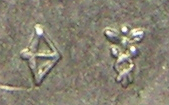This article needs additional citations for verification .(December 2009) |

A privy mark was originally a small mark or differentiation in the design of a coin for the purpose of identifying the mint, moneyer, some other aspect of the coin's origin, or to prevent counterfeiting. One of the first instances of a privy mark used as a counterfeit measure was during the 17th century in a plan proposed by Sir Edward Ford to mint farthings, halfpence and three-farthings. [1]
The main distinction between a privy mark and a mint mark lies in their purposes. Unlike a mint mark, which indicates the coin's place or source of minting, a privy mark may also indicate where a coin was minted and serves as a design and marketing element to honor a significant occasion or denote its inclusion in a specific collection.[ citation needed ] Some privy marked coins—such as the Canadian Silver Privy Marked Maple Leaf —may sell at a premium.[ citation needed ]